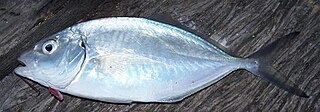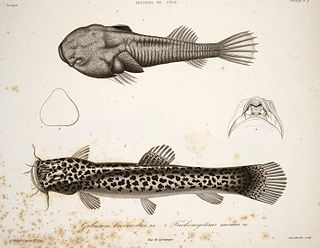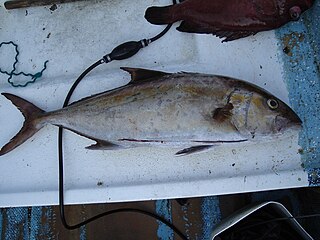
The Carangidae are a family of ray-finned fish which includes the jacks, pompanos, jack mackerels, runners, and scads. It is the largest of the six families included within the order Carangiformes. Some authorities classify it as the only family within that order but molecular and anatomical studies indicate that there is a close relationship between this family and the five former Perciform families which make up the Carangiformes.

Pompanos are marine fishes in the genus Trachinotus in the family Carangidae. Pompano may also refer to various other, similarly shaped members of the Carangidae, or the order Perciformes. Their appearance is of deep-bodied fishes, exhibiting strong lateral compression, with a rounded face and pronounced curve to the anterior portion of their dorsal profile. Their ventral profile is noticeably less curved by comparison, while their anterior profile is straight-edged, tapering sharply to a narrow caudal peduncle. Their dorsal and anal fins are typically sickle-shaped, with very long anterior rays and a succession of much shorter rays behind, with a similarly long & curved, deeply forked tail which has a narrow base. They are typically overall silvery in color, sometimes with dark or yellowish fins, and one or a few black markings on the side of their body. They are toothless and are relatively large fish, up to about 1.2 m (3.9 ft) long, although most species reach no more than half or two-thirds of that size. They are found worldwide in warmer seas, sometimes also entering brackish waters.

The leatherjacket fish or leather jack, Oligoplites saurus, is a species of jack in the family Carangidae. Leather jack may also refer to other members of the Carangidae, such as the pilot fish. The largest are about a foot long.

The white trevally, also known as striped jack,) is a jack of the family Carangidae widespread in tropical and warm temperate areas between 40°N and 47°S, in the Atlantic, Mediterranean, Indian, and Pacific Oceans. It has a deep body and a greenish colour with metallic overtones and a dark spot above the gills. The fins are yellow. Trevally are strong fighters and the flesh is good to eat if a little dry. It is often used as cut bait. Its maximum size is about 120 cm.

The flavescent peacock, also known as Grant's peacock, is a species of haplochromine cichlid. Its common name refers to its "flavescent" (yellowish) colour.

Plectropomus, commonly known as the coral groupers, is a genus of marine ray-finned fish, groupers from the subfamily Epinephelinae, part of the family Serranidae, which also includes the anthias and sea basses. They are found in the Indo-Pacific region.
Rhamphochromis lucius is a species of piscivorous cichlid endemic to Lake Malawi where it prefers deep, open waters. This species can reach a length of 40 centimetres (16 in) TL. It can also be found in the aquarium trade. FishBase treats this species as a valid species, although note that it may be a synonym of Rhamphochromis woodi but the Catalog of Fishes treats it as a synonym of Rhamphochromis esox, as does the IUCN.
Carangoides ciliarius is a dubious species of marine fish in the jack and horse mackerel family, Carangidae. The validity of the species has been questioned by a number of authors, with many concluding it is a synonym of the similar Carangoides armatus, commonly known as the longfin trevally. However, this synonymy has not been accepted by all authorities, with Fishbase and ITIS both recognising it as a valid species. Like Carangoides armatus, the species is occasionally referred to as the 'longfin kingfish'.

Bangana is a genus of fish in the family Cyprinidae, the carps and minnows. It is distributed across much of southern and eastern Asia. Species live mainly in the flowing waters of tropical and subtropical rivers.

Parachaenichthys is a genus of marine ray-finned fish belonging to the family Bathydraconidae, the Antarctic dragonfishes. They are found in the Southern Ocean around Antarctica.

Hemicaranx is a genus of ray-finned fish from the family Carangidae, the jacks, pompanos, scads and trevallies, found in the Atlantic and Pacific oceans.

Selar is a genus of ray-finned fishes from the family Carangidae which includes the scads, jacks, pompanos, trevallies and horse mackerels. The generic name, Selar, is the local name for the oxeye scad in Jakarta.

Selene is a genus of carangids, commonly known as lookdowns and moonfishes, native to the Atlantic Ocean and the eastern Pacific Ocean.
The shortjaw leatherjacket, also known as the slender leatherjacket, is a marine ray-finned fish from the family Carangidae which is native to the eastern Pacific, where it is found from Mexico to Ecuador. It is a pelagic species found close to shore, to depths of 30 metres (98 ft), which can withstand water of low salinity and which can enter estuaries temporarily. This species was formally described in 1904 by Charles Henry Gilbert & Edwin Chapin Starks from a type locality of Panama City market.

Silver trevally, Pseudocaranx georgianus, is a jack of the family Carangidae found around the coast of Australia and New Zealand.

Sicyases brevirostris is a species of clingfish from the family Gobiesocidae. It is endemic to the rocky intertidal zones of the Juan Fernández Islands, Chile. It was described in 1848 as Gobiesox brevirostris by Alphone Guichenot. Fishbase treats Sicyases hildebrandi as synonymous with S. brevirostris although some authorities still treat S. hildebrandi as a valid species.
Strongylura strongylura, the spottail needlefish or blackspot longtom, is a species of needlefish from the family Belonidae. It is found in the Indian and western Pacific Oceans from the Persian Gulf east to Australia and the Philippines. This species occurs in coastal waters and in mangrove-lined lagoons as well as being recorded in estuarine areas and it has even entered freshwater. Living S. strongylura have been found alive and buried in mud during low tide. It is piscivorous, feeding mainly on clupeoids. This species is oviparous and the eggs adhere to objects in the water which catch the tendrils which cover the surface of the egg. Strongylura strongylura under the synonym of Strongylura caudimaculata is the type species of the genus Strongylura. It as originally described as Belone strongylura by Johan Coenraad van Hasselt in 1823 with the type locality given as Vizagapatam, India.

Scomberoidinae is a subfamily of ray-finned fish from the family Carangidae which consists of three genera and 10 species. The species in this subfamily have been given the common names leatherjacket and queenfish.

The fortune jack, also known as the darkfin amberjack, is a species of ray-finned fish from the family Carangidae. It is found in the eastern Pacific from Mexico to Ecuador and on the Galapagos Islands. It is a benthopelagic and demersal fish of coastal areas, including areas of rocky reefs to 30 metres (98 ft). This species was formally described by the Austrian ichthyologist Franz Steindachner (1834-1919) in 1881 with the type locality given as Callao in Peru.

The skipjack trevally or sand trevally is a species of ray-finned fish in the family Carangidae, the jacks, trevallies, pompanos, and scads. It is found in the eastern Indian Ocean around Australia.
















